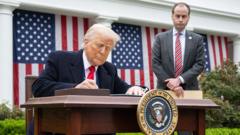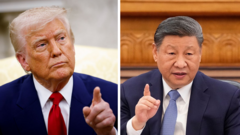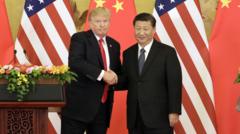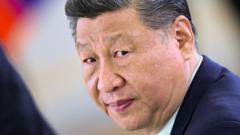In a sweeping move that promises to reshape international trade dynamics, President Donald Trump has rolled out new tariffs that will impact imports across multiple countries. The tariffs, unveiled during a press conference, are designed to ensure economic growth in the United States by targeting trade practices deemed unfair.
Trump Unveils Broad Tariff Plan Targeting Global Trade

Trump Unveils Broad Tariff Plan Targeting Global Trade
US President Donald Trump announces significant tariffs aimed at addressing trade imbalances and protecting American industries, set to be implemented soon.
One of the key components of Trump’s plan is a baseline import tariff of 10%, which all foreign goods will incur starting April 5. This blanket rate will affect a range of countries including the United Kingdom, Brazil, and Turkey, as the government seeks to limit the financial advantages such nations might have over American products. The responsibility of paying this tax falls on importers, which may lead to increased costs for consumers.
In a more aggressive approach, Trump will also impose specific tariffs on about 60 countries identified as "worst offenders" in terms of trade practices. This includes hefty tariffs like 54% on goods from China and 20% from the European Union, set to take effect on April 9. The administration justifies these targeted tariffs by citing instances of high existing tariffs on US goods and various barriers to trade that these nations uphold.
It should be noted that Canada and Mexico are exempt from the new 10% baseline tariff, as existing tariffs are already in place due to previous presidential orders concerning border control and the opioid crisis. Trump has maintained a higher tariff rate of 25% on automotive imports to further bolster American manufacturing interests.
Reactions worldwide have been swift and varied, with many leaders expressing discontent over what they perceive as a detrimental move to global trade relations. As these measures roll out, the international community watches closely, anticipating economic repercussions that could ripple through markets globally.
With these tariffs, Trump aims to fulfill a long-standing campaign promise and assert stronger control over international trade policy, but they stand as one of his most controversial economic strategies yet.
In a more aggressive approach, Trump will also impose specific tariffs on about 60 countries identified as "worst offenders" in terms of trade practices. This includes hefty tariffs like 54% on goods from China and 20% from the European Union, set to take effect on April 9. The administration justifies these targeted tariffs by citing instances of high existing tariffs on US goods and various barriers to trade that these nations uphold.
It should be noted that Canada and Mexico are exempt from the new 10% baseline tariff, as existing tariffs are already in place due to previous presidential orders concerning border control and the opioid crisis. Trump has maintained a higher tariff rate of 25% on automotive imports to further bolster American manufacturing interests.
Reactions worldwide have been swift and varied, with many leaders expressing discontent over what they perceive as a detrimental move to global trade relations. As these measures roll out, the international community watches closely, anticipating economic repercussions that could ripple through markets globally.
With these tariffs, Trump aims to fulfill a long-standing campaign promise and assert stronger control over international trade policy, but they stand as one of his most controversial economic strategies yet.






















